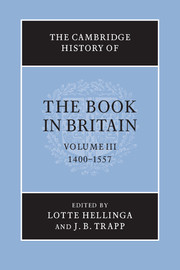Book contents
- Frontmatter
- Introduction
- 1 Literacy, books and readers
- TECHNIQUE AND TRADE
- COLLECTIONS AND OWNERSHIP
- READING AND USE OF BOOKS
- I BOOKS FOR SCHOLARS
- II PROFESSIONS
- III THE LAY READER
- 22 Schools and school-books
- 23 Practical books for the gentleman
- 24 Devotional literature
- 25 Gentlewomen’s reading
- 26 Music
- 27 Literary texts
- 28 Press, politics and religion
- Appendix
- List of abbreviations
- Bibliography
- Photo credits
- General index
- Index of manuscripts
- Bibliographic index of printed books
- Plate Section"
- References
25 - Gentlewomen’s reading
from III - THE LAY READER
Published online by Cambridge University Press: 28 March 2008
- Frontmatter
- Introduction
- 1 Literacy, books and readers
- TECHNIQUE AND TRADE
- COLLECTIONS AND OWNERSHIP
- READING AND USE OF BOOKS
- I BOOKS FOR SCHOLARS
- II PROFESSIONS
- III THE LAY READER
- 22 Schools and school-books
- 23 Practical books for the gentleman
- 24 Devotional literature
- 25 Gentlewomen’s reading
- 26 Music
- 27 Literary texts
- 28 Press, politics and religion
- Appendix
- List of abbreviations
- Bibliography
- Photo credits
- General index
- Index of manuscripts
- Bibliographic index of printed books
- Plate Section"
- References
Summary
It syttyt ffwyll wele a woman to be styll, meke, serwyseabyl, dredfwl, chaste, devoute, warre, sobre, softe, beynge glade, but nat nyce, newere idyl, but eyþer workyng, prayyng, redyng, spynnynge, sewyng or wepyng or mornyng for synne for departyng fro her spowse þt ys Cryste.
Adding this code of conduct, in 1457, to a blank leaf in a copy of the revised Wycliffite translation of St Paul’s Epistles, an otherwise unknown man named Austin Fishmonger firmly set women’s reading in the context of a programme of virtuous activities designed to occupy body and mind. His perception of the value of directed reading is commonplace in the late Middle Ages and early Renaissance, reiterated, for example, by Geoffrey de la Tour-Landry and his English translators, and in Richard Hyrd’s version of Vives’s Instruction of a Christian Woman.
Most fifteenth- and early sixteenth-century books which explicitly recommend themselves to women are directed to those who claim or aspire to ‘gentility’. They are rarely gentry-exclusive, however, in the sense that they might seek specifically to address those of a precisely definable ‘gentry’ class: those whose families ranked just below the peerage, according to one definition, or whose annual incomes from land were assessed at between £10 and £40. In terms of cultural interests, distinctions between gentry and nobility are hard to draw, and would assume a fixity of class distribution which is not borne out by the evidence of social mobility.
- Type
- Chapter
- Information
- The Cambridge History of the Book in Britain , pp. 526 - 540Publisher: Cambridge University PressPrint publication year: 1999
References
- 1
- Cited by



